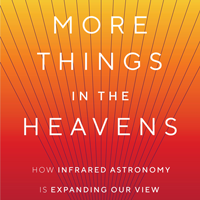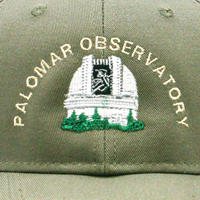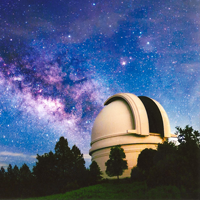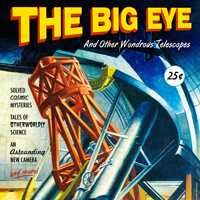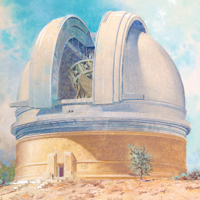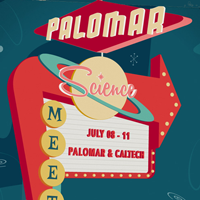Friends of Palomar Observatory Website
Upcoming Events

The Newsletter of the Friends of Palomar Observatory, Vol. 9 No. 2 – July 2014
David Ciardi, Research Astronomer, IPAC/Caltech
David Ciardi from the NASA Exoplanet Science Institute at IPAC/Caltech will give a presentation on July 12 at the Palomar Observatory Outreach Center. His talk will be followed by a star party hosted by the Observatory's docents. Ciardi’s talk is titled:
Finding the Youngest Exoplanets: Palomar Observatory at the Forefront

David Ciardi (D. Ciardi/California Institute of Technology)
Abstract: It has only been 25 years since the first discovery of planets around other stars. Since that time, astronomers have discovered more than 1,700 planets with 2,600 candidates from the Kepler Mission waiting to be confirmed. These confirmed discoveries show that nature creates exoplanetary systems of extraordinary diversity. Yet, little is known about these systems at the earliest stages of their formation. Palomar Observatory has been used at the forefront of astronomy to search for and discover the first transiting exoplanet around a newly formed star. In his presentation, David Ciardi will describe the discovery of the first exoplanet in orbit around such a young star. This detection was made at Palomar Observatory as part of the Palomar Transient Factory and has since been confirmed by observations with the Hale Telescope, the Keck telescopes, and the Spitzer Space Telescope.
The Luiseños Nation, Asteroids, and Palomar Mountain
By Phaedra Hopper, Palomar Observatory Docent
Asteroids are assigned preliminary designations when they are discovered. Once their orbits are determined, they are given a permanent number. The discoverer has the privilege of naming them. The people who make these discoveries take care to name them in a meaningful way. This article will explain why some asteroids discovered at Palomar were named what they were named and the importance of the people for whom they were named.
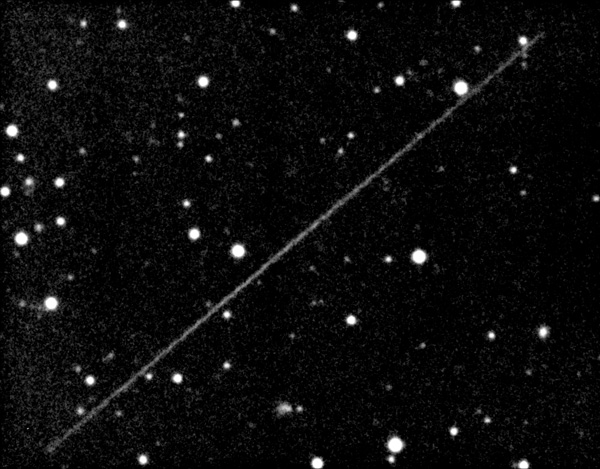
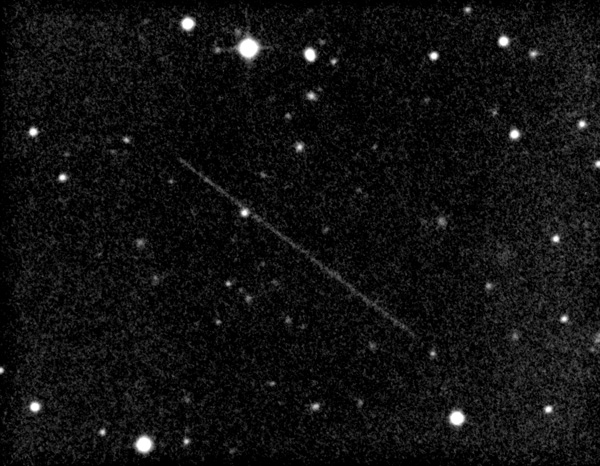

From top to bottom, asteroids (12711) Tukmit, (11500) Tomaiyowit, and (9162) Kwiila. (Palomar Observatory/California Institute of Technology)
Between 1987 and 1991, while doing the Second Palomar Sky Survey, Jean Mueller, currently night operator of the 200-inch Hale Telescope, discovered three new asteroids. Ms. Mueller knew of the cosmology of the local Indians, the Luiseños. She was aware of how it affected all facets of their lives. In naming her discoveries, she chose to honor the Luiseño people, the first people on Palomar Mountain, by using the names of some of their gods: Tukmit (1991) Father Sky, Tomaiyowit (1989) Mother Earth (bearer of the first people), and Kwiila (1987) Black Oak. Father Sky and Mother Earth came together and formed the first people. Black Oak was one of the first people.
The Luiseño territory extends from the coast in northern San Diego and southern Orange Counties and as far as Hemet and the western slope of Palomar Mountain. Luiseño Indians of the Palomar area were frequent visitors to Palomar Mountain. Not only did they hunt and gather food on the mountain, they also had many astronomical sites. There is evidence of sky lore in many writings of early ethnologists. For this reason Dr. E.C. Krupp wrote and presented a paper to the 4th Oxford International Conference on Archeo-Astronomy in 1993 in which he stated the Luiseños were the “The First Palomar Astronomers.”
According to an account written by Constance Goddard Dubois, the people had no names for planets, except for Venus that she was aware of. Wiyot (sometimes Ouiot) the full moon was the first chief. Meteors represented the devil god Taquish, who was said to kidnap people and take them to Palomar Mountain to be eaten.
As Luiseño people looked to the skies, the stars took on major roles in informing their daily lives. Major importance was given to stars, which were considered star chiefs. They were reported to have more names for stars than other tribes in the area. Nukulish was Antares, Yungavish was the name for Altair. Hulachuum was in Orion’s Belt. They did recognize constellations. Cheheam (Pleiades) was a group of sisters being pursued by Coyote (Aldeberan).
The Piiwish Ahuutax (Milky Way) was used in many aspects of the religious practices and daily lives of the Luiseños. Sometimes referred to as “Pale White.” By some accounts, Pale White was lonely so it created two round things which developed into Tukmit and Tomaiyowit. From Tukmit and Tomaiyowit came the first people.
There are many representations of the Milky Way in important religious rituals. A net representing Piiwish Ahuutax was placed in a hole during young men’s initiation. Sand paintings with concentric circles colored white, red and black were used during girl’s initiation to adulthood. The white circle represented the Milky Way. The circles were open to the north, representing the North Star. At the end of life, Piiwish Ahuutax again demonstrated its importance in the culture. The Luiseños believed at the end of their lives they would be guided to the stars to live with their ancestors. To accomplish this, Nukulish, a guide star, led them to the Milky Way, which served as a bridge to the stars. The Milky Way was referred to in many mourning songs to help the travelling spirits to find their way home.
There are many representations of the Milky Way in nature. One found locally is a large granite boulder with a vein of quartz arching over the shape of the rock. It is called the “Wanawut (or Milky Way) Rock.” One end is divided representing the Cygnus rift. It is not known if any religious ceremonies occurred at the site however, according to E. C. Krupp “it was recognized as a station of supernatural celestial power in a sacred Landscape.” (Krupp, Sky and Telescope, 7/2000, “Whiter Shade of Pale.”)
If you are interested in learning more about our first astronomers, please consult the works listed below. There is so much more to know and so many more interesting stories.
- DuBois, Constance G. “The Religion of the Luiseño Indians in Southern California.” University of California Publications in American Archaeology and Ethnology, Vol. 8, No.3, pp. 69-186. 1908.
- Kroeber, Alfred L., “Handbook of the Indians of California.” Bulletin of the Bureau of American Ethnology, No.78 Smithsonian Institution, Washington , D.C. 1925.
- Krupp, E.C., “The First Palomar Astronomers” Presented by Dr. Krupp at the fourth Oxford International Conference on Archeo-Astronomy, 1993.
- Krupp, E. C. “Whiter Shade of Pale.” Sky and Telescope, July 2000. Rambling Through the Skies. pp. 86-87.
- Sparkman, Philip S. The Culture of the Luiseño Indians. University Press, Berkeley. CA. 1908.
Thanks to Jean Mueller for sharing her research and honoring our “First Astronomers.”
Caltech’s Cosmic Web Imager Sheds Light
on “Dim Matter”
By Steve Flanders
Chris Martin, an astrophysicist and faculty member at Caltech, has used the term “dim matter” not to describe some newly discovered and exotic form of matter in our universe. Rather, speaking somewhat tongue-in-cheek, the phrase “dim matter” becomes a short hand way of distinguishing the bright matter of stars and galaxies from the diffuse and faint gas that fills the intergalactic medium (IGM).

Chris Martin (Bob Paz/California Institute of Technology)
Dim matter, Martin argues, though it has been very difficult to observe, is nonetheless very important to our understanding of the evolution of the stars and galaxies of our universe.
Earlier efforts to observe dim matter have relied upon line-of-sight methods. The presence of matter too dark to detect directly may be inferred by this indirect approach. Specifically, the gases of the IGM will tend to diminish the light of objects such quasars located far in the background. As light travels through the IGM from these very distant objects to the Earth, their resulting lessened brightness serves to reveal the presence of this intervening material.
Even so, such observations are limited in part because, though this method may suggest the existence of gas between the galaxies, it can tell us nothing about the distribution of that gas along the line-of-sight.
To Chris Martin’s way of thinking, there is a critical concern here.
“I would like,” he says, “to understand the history of star formation in galaxies and the physical conditions that govern this history.” And Martin is developing a theory that describes a key mechanism driving the evolution of stars and galaxies over long periods of time, a mechanism that reveals the vital role of “dim matter” in the universe.
“I’ve been thinking about the intergalactic medium since I was a graduate student,” Martin argues. “Not only does it comprise most of the normal matter in the universe, it is also the medium in which galaxies form and grow.” Moreover, there is a cycle, he suggests, in which “baryonic gas that begins as the intergalactic medium ultimately finds its way into galaxies and stars” and, after fueling star forming processes, is fed back into the IGM by the galaxies themselves.
This concept of the IGM lifecycle is important—but difficult to confirm using line-of-sight methods. To get past these limitations, Martin has pushed forward a number of innovative techniques. He is Principle Investigator for the GALAX mission, the Galaxy Evolution Explorer that NASA launched to map the sky in the ultraviolet. In addition, his team is currently flying a balloon—FIREBALL—that is attempting to detect the emissions of the IGM from high in the atmosphere. And there is some subtlety in this because, composed largely of hydrogen, the weak signal of the IGM is most prominently detected in the ultraviolet.
But, since ultraviolet light is absorbed by the atmosphere, it means that ground based observers must look to regions that have a redshift of 2 or greater where these ultraviolet emissions have been shifted into the visible spectrum.
With this in mind and working with colleagues at Caltech and at other institutions, Martin has constructed an instrument for the Hale Telescope named the Cosmic Web Imager (CWI). With the goal of detecting and mapping emissions from the filaments that make up the IGM, the CWI is an imaging spectrograph that takes a large number of images at different wavelengths simultaneously. A powerful investigative technique, the CWI makes it possible to learn about the composition, mass, and velocity of the thin gas cloud that lie around and between the galaxies.
Using this technique, Martin has detected a massive blob of gas that existed 2 billion years after the Big Bang at a time of rapid star formation. “I think we’re looking at a giant protogalactic disk,” he argues, that is “almost 300,000 light years in diameter, three times the size of the Milky Way.”
In fact, the methodology of CWI has been so successful in its implementation on the Hale Telescope that Chris Martin is constructing a multi-channel device, the Keck Cosmic Web Imager, for the Keck Telescopes. Techniques and methods that will continually be under development, “these experiments,” Martin insists, “can be used to make many other new and path-breaking measurements.”
Ask This Old Docent

Dear Old Docent:
I was at a Palomar outreach event some time ago. I was speaking with two of the docents and asked what I thought was a simple enough question: Looking outward, at what place in the sky did the Big Bang take place? Or, if everything is expanding from a point, where is that point? Simple perhaps but the two docents launched into conflicting descriptions and eventually they came close to getting into an argument. One of them started talking about spots on a balloon while the other yammered on about raisin bread. I got so confused! Please help me make sense of this!
Signed, Yammered-in-Yuma
Dear Yammered:
The remarkable thing is the the Big Bang event took place not just at one point in the sky, but at all points everywhere! All of what we perceive as space was once part of the initial Big Bang “singularity.”
That said and to get to your question, let us also point out that, oh yes, we do have our cast of characters here. Even so, this Old Docent would like to assure you that in all likelihood the two eccentrics who spoke with you that evening meant well even if at the time it may have appeared as thought they were simply spreading confusion.
First of all, please understand that, as you might have guessed, your question brings up some ideas that are not at all simple, matters that are very difficult to illustrate using examples from the conventional world around us. Yet, both of the images of the universe that these two docents were trying to communicate are directed at giving substance to the same concept: the galaxies are moving apart not in the manner of debris flying away from an explosion but rather as flotsam being carried along on the movement of the tides.
Of the two, the Old Docent is loath to take sides in the argument. Still, to keep this simple, it seems best to set aside the balloon image for the moment and pickup the idea of the raisin bread.
Imagine, if you will, a freshly made lump of dough that has been loaded with an abundance of raisins. As the loaf begins to rise, every raisin begins to move away from every other raisin. The raisins are not moving through the dough; the dough is expanding around the raisins carrying each raisin away its neighbors. If you had transparent dough and you could stand on any one of the raisins, it would seen as though you were at the center with everything moving away from you.
Of course, the dough represents what we conventionally think of as “empty” space. And in fact space is expanding all around us carrying with it all of the galaxies as well as that box of Sun-Maid raisins in your kitchen cabinet.
Or, said another way, expansion is a property of the universe itself. There is no center of expansion to look for because we are in a universe that is expanding around us, a condition that creates a geometry that makes it look as though our own planet were at the center of everything.
Needless to say, this is not the first time in the story of our struggle to understand our circumstance that we have had to deal with illusions of this sort.
That said, there are, of course, any number of complications that have been trampled upon by this too simple analogy. In fact, the raisin bread image greatly distorts this geometry and forces the universe to conform to the nice three-dimensional existence we perceive in the day-to-day world.
It is not that way. The loaf of bread incorrectly suggests a comfortably square universe but the balloon analogy the other docent talked about tries to get to a more complex concept.
You see, as the balloon inflates, the distances between the spots on its surface become greater and, seen form the surface, each spot appears to be moving away from every other spot just like the raising in the rising loaf of bread. But the complex issue of this balloon analogy centers on the idea that we inhabit a finite but unbounded universe, an idea best represented using the two-dimensional surface of the balloon. Indeed, the balloon has a limited area but one without boundaries. The universe works that way but we cannot illustrate this geometry in three dimensions.
In this way, both of the docents you spoke with that day were trying in different ways to get at two sides of the same story of the expansion of the universe.
And, in any event, thank you. This Old Docent treasures these kinds of discussions because the particular point you have brought up here will always generate a cascade of related concerns: How do we know that all —or most—of the galaxies are moving away from us? How long has this been going on? Will expansion go on forever? How is possible that for a short period the universe actually expanded at rate much faster than the speed of light?
Yes, as should always be the case in science, the list of questions goes on and on.
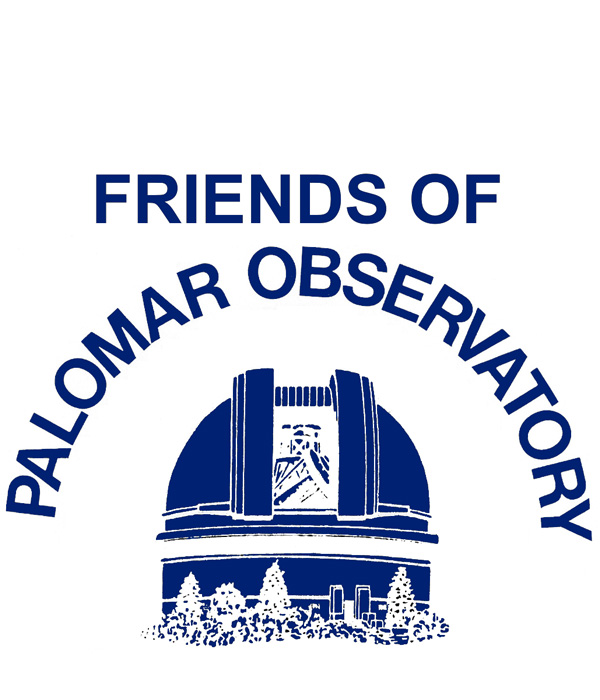
Questions? We've answered many common visiting, media, and academic questions in our public FAQ page.
Please share your feedback on this page at the
COO Feedback portal.
Big Eye 9-2
Last updated: 30 June 2014 SBF/ACM
